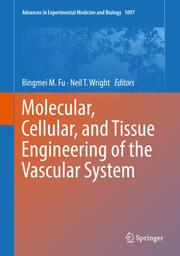-
Zusatztext
-
This book introduces the latest research in molecular, cellular, and tissue engineering of the vascular system. Topics covered include the roles of endothelial surface glycocalyx as a mechano-sensor and transducer for blood flow, a barrier to water and solute transport across the vascular wall and to the interaction between circulating cells and the vessel wall, the roles of nuclear envelope proteins and nuclear lamina in regulating vascular functions under blood flow-induced forces, and the roles of smooth muscle cells and extracellular components in arterial vasoconstriction. Other topics covered include non-surgical vascular interventions for coronary artery diseases, genesis and mechanisms of atherosclerotic plaque microcalcifications and human abdominal aortic aneurysms, experiments and modelling for red blood cell and tumor cell movement in microcirculation, transport across the blood-brain barrier and its role in Alzheimer's disease, mathematical models for cell survival after hyperthermia, application of hypothermia in enhancing treatment for brain and spinal cord injuries, and damage of eardrums due to blast waves. This is an ideal book for biomedical engineers and researchers, medical researchers, and students in biomedical engineering and medical sciences.
-
-
Kurztext
-
This book introduces the latest research in molecular, cellular, and tissue engineering of the vascular system. Topics covered include the roles of endothelial surface glycocalyx as a mechano-sensor and transducer for blood flow, a barrier to water and solute transport across the vascular wall and to the interaction between circulating cells and the vessel wall, the roles of nuclear envelope proteins and nuclear lamina in regulating vascular functions under blood flow-induced forces, and the roles of smooth muscle cells and extracellular components in arterial vasoconstriction. Other topics covered include non-surgical vascular interventions for coronary artery diseases, genesis and mechanisms of atherosclerotic plaque microcalcifications and human abdominal aortic aneurysms, experiments and modelling for red blood cell and tumor cell movement in microcirculation, transport across the blood-brain barrier and its role in Alzheimer's disease, mathematical models for cell survival after hyperthermia, application of hypothermia in enhancing treatment for brain and spinal cord injuries, and damage of eardrums due to blast waves. This is an ideal book for biomedical engineers and researchers, medical researchers, and students in biomedical engineering and medical sciences.
-
-
Autorenportrait
- Bingmei M Fu is a Professor of Biomedical Engineering at The City College of the City University of New York. She received her BS and MS in Modern Mechanics from the University of Science and Technology of China, her Ph.D. in Mechanical Engineering from the City University of New York and her postdoctoral training in School of Medicine at the University of California, Davis. Prior to her appointment at City College, she was an Associate Professor in Mechanical Engineering at the University of Nevada, Las Vegas. She is a fellow of the American Institute for Medical and Biological Engineering and a member of the Biomedical Engineering Society and the American Association for the Advancement of Science. Her major research activities involve modelling nano and micro transport phenomena in the microcirculation, and corresponding in vivo animal and in vitro culture cell experiments. Neil T. Wright is an Associate Professor of Mechanical Engineering at Michigan State University. He received his BS in Engineering Science and Mechanics from Virginia Tech, his MS in Mechanical Engineering from the University of Colorado, and his PhD in Mechanical Engineering and Applied Mechanics from the University of Pennsylvania. Prior to his appointment at Michigan State, he was an Associate Professor at the University of Maryland, Baltimore County. He is a fellow of the American Society of Mechanical Engineers and a member of the Biomedical Engineering Society and the American Association for the Advancement of Science. His laboratory measures the thermophysical properties of biological materials and superconducting niobium.
Detailansicht
Molecular, Cellular, and Tissue Engineering of the Vascular System
Advances in Experimental Medicine and Biology 1097
ISBN/EAN: 9783319964447
Umbreit-Nr.: 5249948
Sprache:
Englisch
Umfang: viii, 334 S., 19 s/w Illustr., 65 farbige Illustr.
Format in cm:
Einband:
gebundenes Buch
Erschienen am 26.10.2018
Auflage: 1/2019


